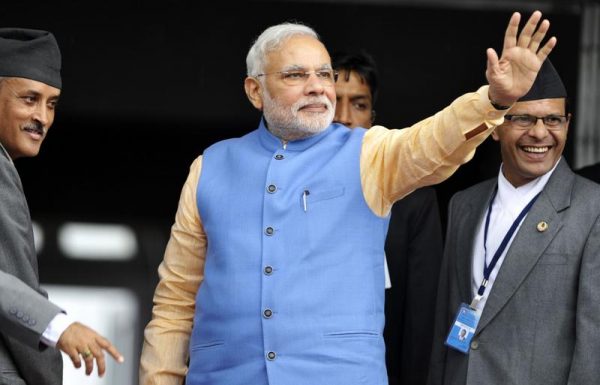No doubt concern over China’s massive aid-driven inroads in the region (and the corresponding concern over how to reassert India’s dominance there) had a huge impact on the ordering of New Delhi’s priorities. It was just as certain, however, that India’s new leadership, in crafting Modi’s foreign travel agenda, recognised the crucial importance to India’s economic and strategic future of Himalayan Asia’s immense river resources. Indeed, whatever else the now unfolding Modi era means for India, it seems more than likely, to borrow from the title of Norman Maclean’s fine novel, that rivers will run through it.
Water resources (hydroelectric power in particular) were the centrepiece of Modi’s visits to both Bhutan and Nepal. In Bhutan, he laid the foundation stone for the 600 megawatt Kholongchu hydroelectric power station. This is the seventh in a lengthening list of major joint hydropower ventures between India and Bhutan targeting 10,000 megawatts in hydropower cooperation by 2020.
In Nepal, Modi laboured to finalise two key hydropower pacts — a Power Trade Agreement and a Power Development Agreement — aimed at reviving long-stalled joint energy projects. Without their formal acceptance, foreign investment, heavily contingent on investment security, is extremely unlikely. Modi’s efforts in this regard were sweetened with a US$1 billion soft loan for Nepal’s use in developing infrastructure and energy projects.
The enormous importance to the Bhutanese economy of Indian investment in developing Bhutan’s hydropower resources, in company with Bhutan’s de facto quasi-protectorate status, helped ensure the success of Modi’s visit to Thimphu. The far less congenial relationship between Kathmandu and New Delhi, burdened with decades of distrust and neglect, does not augur well for the swift growth of hydropower cooperation between them.
Neither of the two needed hydropower pacts were signed during Modi’s visit to Nepal; and negotiation will likely be protracted and difficult. On the surface, this is more than puzzling. For its part, India — faced with an officially estimated 5 per cent power shortage in the current fiscal year and burdened with a daily power outage of 30,000 megawatts — has an obvious interest in Nepal’s hydropower resources. Nepal, meanwhile, has an equally compelling interest in exporting these resources to India. It is one of the poorest and least developed countries in the world: an estimated one quarter of its population of about 28 million people lives below the poverty line.
And yet, if measured in terms of exploitable inland water resources, it is one of the richest countries in the world. There is broad agreement that it possesses at least 40,000 megawatts of economically and technically viable hydropower potential. Yet Nepal’s current installed capacity stands roughly at a stunningly meagre 680 megawatts.
The puzzle largely vanishes, of course, once one recognises that the circumstances surrounding the India–Nepal relationship put up a formidable obstacle to cooperation. Anti-India sentiment, exploited politically by the strong Maoist bloc, is rife among Nepalis. So any deal with India is viewed with suspicion. Indians, too, have reasons of their own to be suspicious. Having observed a decade of Maoist insurgency followed by chronic political instability, including five prime ministers in five yearsand a stalemated effort to forge a new constitution, they naturally have little confidence in the durability of the present coalition government. Neither are Indians much reassured by Nepali insistence that India has nothing to fear from China’s increasingly prominent role in Nepal’s infrastructural development.
Even if Modi’s Nepal initiative turns out to have positive material results, it will fall well short of his presumed goal of forming an economically integrated region. Achievement of that lofty objective won’t come soon or easily. Modi did manifest unusual political boldness in the issuing of an unconventional invitation to all the leaders of India’s South Asian neighbours to attend his inauguration — and, not least, in offering a widely hailed ‘historic handshake’ to Pakistan’s Prime Minister Nawaz Sharif.
But drawing all of the region’s states, and in particular the two giant Muslim-majority states, Bangladesh and Pakistan, into India’s orbit is work of an entirely different order. Modi’s accusation that Pakistan is waging proxy war in Kashmir, made on a recent trip to Ladakh, in company with frequent reports of violations of the 2003 ceasefire agreement between the two states, is a blunt reminder of this. Moreover, China is highly unlikely to relax its efforts to bring India’s South Asian neighbours more fully into its own orbit. And few, if any, of these neighbours are likely to accept without reservation Modi’s repeated assurances that India comes not to dominate but to build trust.
Modi undoubtedly displayed commendable political nerve in his innovative selection of foreign visits and friendly gestures towards erstwhile adversaries in the first months of his government. However, he will establish himself as a regional and not just Indian leader to the extent that he is able to convince neighbouring populations that India’s goals in the region are largely in harmony with their own and that cooperation, not conflict, will be the watchword of his government.
In this era of increasing water scarcity and the mounting threat of climate change, it would not be amiss if he chose to expand upon the hydropower initiatives witnessed in the Bhutan and Nepal visits and offer to all India’s neighbours across-the-board joint partnerships in the development of water resources. One can hardly imagine a more urgently needed change in the way water resources are managed in the region. Neither could there be a more convincing way to demonstrate India’s commitment to a truly regional vision.
Robert G. Wirsing is Professor at Georgetown University’s School of Foreign Service in Qatar.

